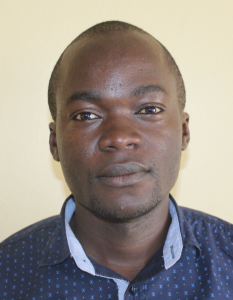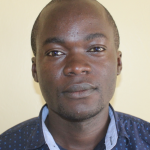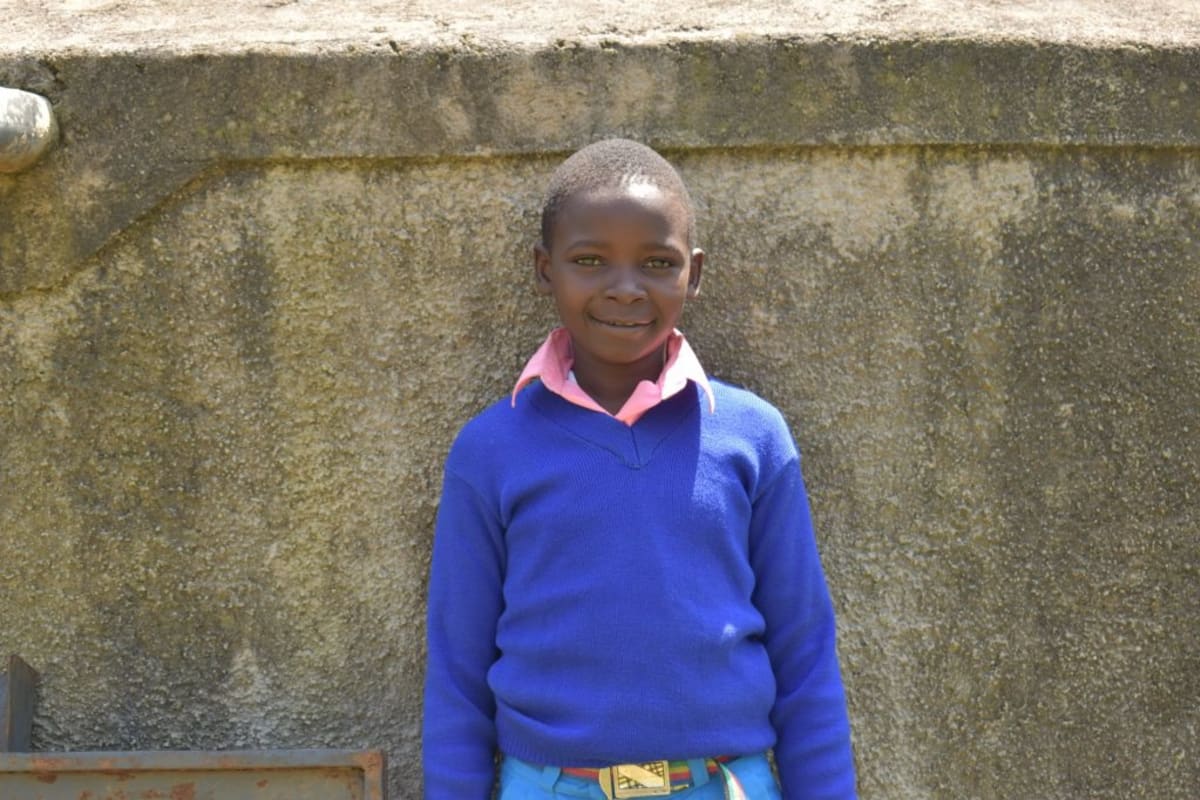May, 2020: Kapsaoi Primary School Project Complete!
Please note, all photos in this report were taken before social distancing recommendations went into effect.
Kapsaoi Primary School in Kenya now has access to a new source of safe, clean water thanks to the completion of their rain tank, which has the ability to collect 75,000 liters of water! We installed new latrines and handwashing stations for students, and we trained students and staff on improved sanitation and hygiene practices. All of these components work together to unlock the opportunity for these students to live better, healthier lives.

Students pose with the completed rain tank
"As pupils, we are grateful to have this project in our school. Lives have changed in terms of accessing clean and safe water for drinking and washing hands. Also, no more carrying water from home," said student Adija.

Student Adija
"Now, our grades will improve a lot because of no longer wasting time. This project is a golden gift for us. Our school image will change in terms of development."

Boys celebrate the rain tank
Teachers were just as excited as the students about the new rain tank on campus.
"As a teacher of this school, I can say we have been suffering for so long in terms of time-wasting, diseases for long periods of time, and for sure this is the end, and we thank Almighty God for this," said teacher David Bengat.
"Secondly, teaching will run more effectively compared to the past...The school's mean grade will be achieved, and even practical lessons will take place. More so, hygiene standards will improve."

Pupils pose with staff and teachers at the rain tank
While Kenyan schools remain closed until further notice due to the COVID-19 pandemic, these new water and sanitation facilities will be ready and waiting for the students' return.

A pupil turns off the tap at the rain tank
Rain Tank
Construction for this 75,000-liter rain tank was successful!
Before schools closed, parents, staff, and students helped our artisans gather everything needed for construction. All the while, the school cooks and community members prepared meals for the artisans, and the school provided accommodations for the artisans during their work. Local women and men helped our artisans with their manual labor, too.

Community members helped deliver water and stones to the rain tank construction site at school
The process officially began with our staff and school administration looking around the school compound to try and determine the best location for a new rain tank. This needed to be the best site with enough land and a nearby building with good, clean roofing to catch the rainwater.

Rain tank foundation excavation
Then, we cleared the site by excavating the soil to make level ground for the tank foundation. The foundation was cast by laying big stones on the level ground and reinforcing them using steel wire, concrete, and waterproof cement. We affixed both the drawing pipe and the drainage pipe as we laid the foundation.

Stones and steel wire make up the first layers of the rain tank foundation
Next, the walls were formed using a skeleton of rebar and wire mesh with sugar sacks temporarily tied to the outside as backing. This was attached to the foundation’s edges so that the work team could start the Ferro-cementing process, in which the walls are layered with cement alternating with the inner and outer side until 6 layers of cement are in place. (The sugar sacks are removed once the interior receives its first 2 layers of cement.)

Fitting the wire skeleton around the cemented rain tank foundation
Inside the tank, 1 central and 4 support pillars were cast to ensure the dome does not cave in once cemented. Meanwhile, the inner wall was plastered while the outer walls received their roughcasting. Outside of the tank, the access area to the tap was dug, plastered, and a short staircase installed, along with a soak pit where spilled water can drain from the access area through the ground. This helps to keep the tap area dry and tidy.

Outer plasterwork as interior tank walls and pillars dry
Dome construction could begin after the tank walls had been given enough time to settle. Using similar techniques as used on the walls, the dome started as rebar, wire mesh, and sugar sacks and was attached to the tank walls before receiving cement and plaster. A small manhole cover was built into the dome to allow access for future cleanings and water treatments.

Sewing sugar sacks to dome wire skeleton
Long wooden poles (about 75 of them!) were placed inside the tank to support the dome while it cured. A lockable manhole cover was fitted over the tap area, the gutters were affixed to the roof and the tank, and an overflow pipe was set in place at the edge of the dome for when the tank reaches capacity.

Cementing the dome
Once finished, the rain tank was given 3-4 weeks to undergo complete curing. Finally, the interior support poles and dome sugar sacks were removed, the tank was cleaned, and we waited as rain filled the tank with fresh water. When there was a sufficient volume in the tank, we treated the water and we officially handed it over to Kapsaoi Primary School.

"Skirting" the dome to remove overhanging plaster and create a cap on the tank
As soon as it was ready, students and staff celebrated the presence of clean water on campus. The event was a great chance for us to acknowledge the school administration and students as the primary parties entrusted with the tools we have given, as well as remind them of our continued support as they develop. Happiness, thanksgiving, and appreciation were the order of the day flowing in all directions.

Students pose while fetching water from the rain tank
VIP Latrines
This project funded the installation of 6 new ventilated improved pit (VIP) latrines, half for girls and half for boys.

Pupils and staff pose in front of the new girls' latrines
All of these new latrines have cement floors that are designed to be easy to use and clean, locking doors for safety and privacy, and vents designed to keep air flowing up and out through the roof. With a rain tank right on school property, there should be enough water to keep them clean.

Boys saying "Thank you!" for their new latrines
Handwashing Stations
The 2 handwashing stations were set up during training and handed over to the student health club. These were placed outside of the girls’ and boys’ latrines to encourage handwashing after latrine use.

A pupil washes her hands as her classmates peer out from their new latrines
Health club members will teach other students how to properly wash their hands at the stations, make sure the stations are filled with water, and work to ensure that there is always a cleaning agent such as soap or ash available.

A boy washes his hands after using the new latrines
New Knowledge
Hygiene and sanitation training was scheduled with the help of the school principal and the head teacher, who together ensured that the training date would be convenient for students, staff, and parent representatives. Individual teachers helped by selecting students from each class to represent the others. When the training day arrived, facilitators Victor Musemi and Samuel Simidi deployed to the site.

Pupils in group discussions at training
22 students attended training, which was held outside under the shade thanks to the trees on the school's compound. The pupils had high expectations and an eagerness to learn, contributing to the strong turnout and level of participation throughout the training.

Students lend an ear to the instructors Victor and Samuel
We covered a number of topics including personal hygiene such as bathing, oral hygiene, and the 10 steps of handwashing; environmental hygiene; child rights; operation and maintenance of the rain tank, latrines, and handwashing stations; and leadership and governance. During the latter, the students elected their peers to lead their newly formed student health club.

Trainer Samuel uses a poster for the dental hygiene session
Because we held this training when the spread of COVID-19 was still in its early stages and was not yet worldwide, this was not a topic we covered. Since then, however, we have developed trainings exclusively on COVID-19 prevention and awareness - see for yourself what we've been up to more recently as we continue to fight COVID-19 on the frontlines in all of the communities we serve.

A student presents his group's work with the help of a visual aid held by Trainer Samuel
The student health club will be greatly involved in the water, sanitation, and hygiene project management at school and will be responsible for encouraging good health and hygiene practices amongst their peers, teachers, and the larger community. We involved stretches, dances, and physical activities in between each topic to keep the pupils’ energy up and their minds active. By the end of the training, each pupil understood their role in sustaining clean water and good health within their school community.

Trainer Victor demonstrates the 10 steps of handwashing
One of the most enjoyable topics for the group was the session on general health as under this topic, the facilitators were able to differentiate between environmental hygiene and personal hygiene. The participants were very interested in this, and many pupils were able to practice toothbrushing and even draw charts to show different parts of the teeth. We also used this session to clean the school's compound as a part of a hands-on practical to demonstrate the high level of cleanliness the student heath club is expected to help uphold.

A student tries out the new handwashing station at training
Leadership and governance was the second most memorable topic. In many schools students are at first unsure of the qualities of a good leader, but not this group. These students were quick to identify the qualities of a good leader which resulted in their election of a "brilliant, intelligent girl to manage the top seat of the student health club" Trainer Victor said.

Pupil Selestine holds a clean cup of water from the new rain tank
"Knowledge is power and I have gained a lot," said pupil Selestine after completing training.
"My life will change in many ways. One, good health will make us prosper in academics and even the school community will develop. This will also lead us to teach others and be role models for them."

Making a splash at the new rain tank
When an issue arises concerning the water project, the students and teachers are equipped with the necessary skills to rectify the problem and ensure the water point works appropriately. However, if the issue is beyond their capabilities, they can contact our team of field officers to assist them. In addition, we will continue to offer them unmatchable support as a part of our ongoing monitoring and maintenance program.
Thank you for making all of this possible!


 Rainwater Catchment
Rainwater Catchment
 Rehabilitation Project
Rehabilitation Project



















































